Abstract
In the context of “smart cities” and stock-based development, street renewal focuses more on quality and sustainability in China. To improve the efficiency of current smart technology applications, a comprehensive whole-life cycle system needs to be established in street space. After sorting out the application of smart technologies in the street design guidelines (SDGs) for typical cities in China, the compilation and application of smart technologies for sustainability were categorized into five areas: smart transportation, convenient living, life enrichment, the protection of vulnerable people, and environmental monitoring. Based on theoretical support and realistic needs, a smart street management and control platform (SSMCP) was built. The SSMCP is divided into four layers: the basic information layer for the background, the technology platform layer for the core processing, the institutional protection layer for the guarantee mechanism, and the scene application layer for spatial interactions. The results can provide a scientific reference for improving the sustainability of street space and implementing a “smart cities” project at the street level.
1. Introduction
The evolution of the digital age brought about changes in smart technologies, giving rise to efficient development in many fields worldwide, such as finance, the military, ecology and environment, social and economic life, and so on [1]. In the field of urban construction, the promotion of smart cities through smart technologies has broadened its scope of application. Smart cities apply computing technology in urban planning and construction management, such as cloud computing, big data, and spatial geographic information, which make urban infrastructure more interconnected and efficient, while empowering the government with efficient operation and management mechanisms, as well as providing better living services for people [2]. As constructing a “smart city” is a significant strategic opportunity, smart construction, the smart coordination of resources, and the smart management of data has advanced rapidly in China [3]. In December 2015, the China Central Urban Work Conference noted that urban renewal should conform to the “new normal”, adhere to the concepts of “smart growth” and “stock-based renewal”, and promote the transformation of urban development for connotative growth [4,5]. Smart technologies should be focused on actively promoting the sustainable construction of urban public spaces in relation to the aspects of health, safety, and livability [6,7]. Therefore, the mode of enhancing the competitiveness of cities through smart technologies and sustainable development has gradually reached a consensus [8]. Applying smart technologies to the redesigning of urban space has become possible [9].
The use of smart technologies to realize stock-based development is gradually being explored in China. The city information model (CIM) has been developed to serve as the basis of smart construction [10,11]. The data-control platform elements present the characteristics of a giant system with multiple objects, departments, and levels [12]. Currently, there are several problems, such as urban data silos, single-data scenarios, a lack of information technology [13], and unsound operation and management systems [14]. In terms of street space, the application of smart technologies lacks theoretical support and overall control of the whole-life cycle, and there is insufficient consideration of the concepts of overall management and control, planning, and co-governance construction.
The city is a complex mega-system, with many sectors involved in the design of street space [15]. Street space contains many elements, and street space management involves many construction departments, as its functions are comprehensive and complex [16]. Research on developing smart street space in China began in 2016. Shanghai issued the first city-level SDGs, which answered the questions: “what kind of sustainable streets should be built?” and “what kind of smart technology should be applied?”. Since then, several SDGs have been successively compiled and have continuously enriched the connotations of street space according to local circumstances (Figure 1). However, the overall coordination of the system of traffic, municipal pipelines, landscape, and urban furniture is unclear. As the SDGs provide more explicit valuable concepts and mature technical support, using smart technologies to build a comprehensive system has become an effective way to achieve sustainable development. Promoting street renewal requires a robust and comprehensive platform for the overall planning, design, and management of street space [17,18].
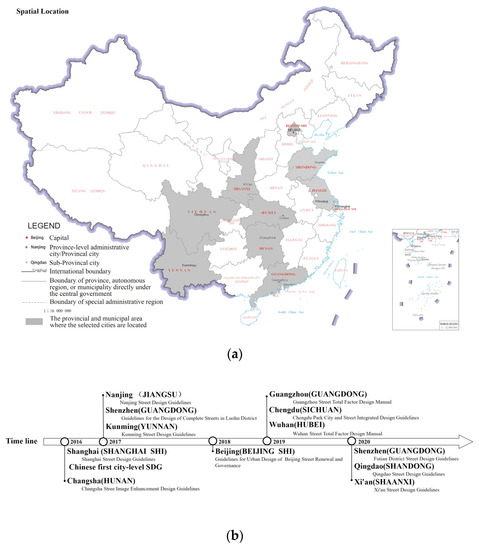
Figure 1.
Spatial locations and timeline of SDGs in China ((a): spatial location; (b): timeline). Source: by author on the basis of data from [19,20,21,22,23,24].
In the context of smart cities, the use of smart technologies is becoming more widespread. Following the achievements of China’s smart city construction and stock-based renewal, this study demonstrated the validity and necessity of improving sustainability and quality in street space based on analyzing SDG data. The SDG data obtained in this paper allowed us to sort out the types, ranges, and methods of application of smart technologies in each selected case. Meanwhile, in the process of analyzing data, some insightful details were highlighted as figures. After comprehensive comparison, a summary of the applications of various smart technologies, which was the theoretical basis as well, was created to present the scenarios of application and technical equipment of SDGs. Based on those details and the theoretical basis, a comprehensive platform was explored, which was the Smart Street Management and Control Platform (SSMCP) (Figure in Section 3.3). This research aimed to show an integrated real-case framework for a whole-life-cycle system based on street space, which can be of significance for smart cities research in China in the future.
2. Methods and Data
2.1. Experimental Methods
The literature review method was used in this study to analyze the SDGs of typical cities in China, and a qualitative comparative analysis method was used to build the SSMCP framework. The literature review method is a systematic way of locating and analyzing arguments. It can aid in formulating search strategies for different databases, conducting systematic studies on a particular issue, and drawing conclusions. The literature review method comprises four steps: question raising, literature determination, data extraction, and presentation of conclusions [25]. In this paper, a sustainable perspective on smart technology was proposed, and the retrieval object was determined to be the SDGs of typical cities in China. The focal points of the SDGs were summarized via text sorting. A qualitative comparative analysis method was then used to identify shared attributes in the scientific information presented in the literature. Based on the essential differences between different city development visions, the wholes and the parts that need to be compared in each city were identified, and the sustainable development and smart technology applications were summarized. This method ensured that the path of the comparative analysis could distinguish the focuses and commonalities and the underlying causal logic could be explored [26]. Based on the literature review and comparative analysis, the framework of the SSMCP was proposed.
2.2. Experimental Data
The present study analyzed the SDGs of five typical cities in China. SDGs are specialized and systematic technical manuals and methods for guiding construction and design [27]. Each of the five typical cities is endowed with unique themes and characteristics (Table 1). As China’s capital city, Beijing assumes the function of a window onto city life. To optimize the elements of street space, the SDGs put forward the requirements for sustainable development as their orientation, and they highlight the value of delicate design. Value transformation emphasizes a people-oriented priority; holistic management and control; and diversified collaboration, coordination, and overall planning [28]. Shanghai is envisioned as actively responding to new urban construction and building a modern city that is harmonious, livable, vibrant, and distinctive. It also advances the construction goals of “prosperity and innovation, health and ecology, happiness and humanity”, which lend a focus to transforming the mode of urban development and achieving endogenous growth through organic renewal. To further implement harmonious and livable spaces, the guidelines emphasize strengthening street design, improving service supply, and shaping the city spirit [29]. Shenzhen promotes the general theme that “the core of the city is people”. There, urban development is expected to adhere to the principle of moving from “Shenzhen speed” to “Shenzhen quality”. Their guidelines indicate that urban renewal and ecological restoration should be carried out on the micro-level of street space to improve urban quality. The development goal of “safety, vitality, beauty, wisdom, and green” is supported by smart facility planning and design [30]. Against the background of stock-based development, Nanjing is committed to promoting the transformation of urban development through urban design. The guidelines emphasize convenience and a sense of the scale of streets as standards for measuring the degree of perfection. Focusing on the goal of “building a modern international humanistic and green city”, the guidelines highlight a “green, humanistic, smart and intensive” orientation [31]. Qingdao emphasizes that the human living environment is the intrinsic driving force of urban development. The guidelines introduce the four concepts of “people-oriented, spatial coordination, organic integration, and system coordination”, which create an engine for sustainable street-level development.

Table 1.
Overview of the five typical cities. Source: by author on the basis of data from [19,20,21,22,23,24].
3. Discussion and Results
3.1. Selected Case Studies on Smart Technology Application
The sorting of the selected cases was conducted, and all the smart technologies and application scenarios were recorded. Some especially insightful applications from selected cases were highlighted with figures.
3.1.1. Beijing
The Guidelines for the Urban Design of Beijing Street Renewal and Governance promote the development of technology applications from the perspective of efficiency and sustainability (Table 2) [19]. The guidelines propose that technologies are used for smart transportation, and they advocate that signal light poles should hold some electronic equipment (Figure 2a) and be integrated to save space. The guidelines present a vision of multifunctional combinations of urban furniture, allowing that furniture to provide a more comprehensive range of convenience services, such as newsstands (Figure 2b). In addition, from the perspective of environmental monitoring, sensors on the streetlamp shades could monitor the microclimate in real time by collecting various types of data, such as on air pollutants, light intensity, noise, heat islands, etc. The sensors could also monitor the flow of people and calculate signaling data to assess street vitality, ultimately giving feedback to managers via wireless networks. The guidelines also suggest that street-level data could be shared and first-hand information could be used for terminal analyses.

Table 2.
The applications of smart technologies in the Beijing SDGs. Source: by author on the basis of data from [19].
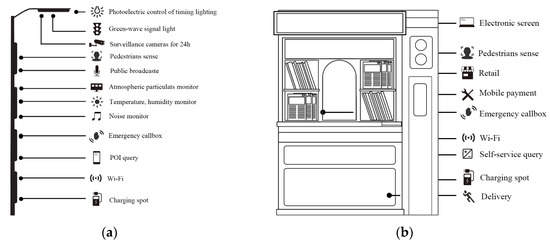
Figure 2.
Urban furniture design recommended in the Beijing SDGs ((a): light pole; (b): newsstand). Source: by author on the basis of data from [19].
3.1.2. Shanghai
The Shanghai Street Design Guidelines state that new materials and technologies applied in the street space should achieve sustainable development [20]. The sustainable construction of streets according to the guidelines can be summarized as relating to five aspects: transportation, life, vitality and enrichment, safety, and the environment (Table 3). The guidelines propose that the coordination of transportation facilities is more efficient in facilitating residents’ mobility. As relates to the aspect of convenient living, the installation of electronic-screen-realized multisource information dissemination and real-time release of various city information is recommended. The guidelines also state that the consolidation of municipal facilities into a facility belt should be encouraged (Figure 3). As an improvement for life enrichment, some communications media were incorporated into public art installations. The application of audio, video, and heat-sensing technologies could improve self-protection. The use of interactive media, data terminals in urban furniture, and multiple sensors achieve monitoring and management of the living environment. The guidelines also propose that data should be collected and feedback provided so as to dynamically adjust urban activities via various smart technologies. The establishment of a comprehensive smart city platform is also proposed to analyze different activities.

Table 3.
The applications of smart technologies in the Shanghai SDGs. Source: by author on the basis of data from [20].
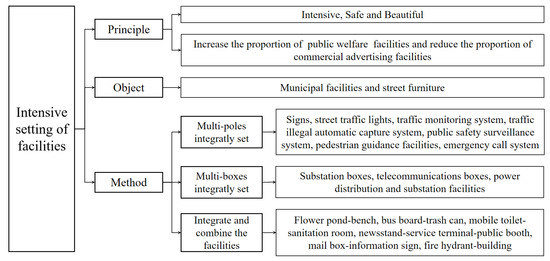
Figure 3.
The integration modes of street space noted in the Shanghai SDGs. Source: by author on the basis of data from [20].
3.1.3. Shenzhen
The application of smart technologies in Shenzhen’s SDGs is reflected in smart transportation, convenient living, the protection of vulnerable people, and environmental monitoring (Table 4) [21,22]. In terms of smart transportation, the guidelines state that technologies such as radar and geomagnetic induction could be used in signal light poles to record the spatial and temporal characteristics of people and vehicles in traffic. In regard to convenient living, the guidelines propose the concept of a smart life micro-hub, which could provide customized demand services (Figure 4). Considering vulnerable people, the feasibility of providing protection could be enhanced through the application of infrared thermal imaging facilities and sound devices. Regarding environmental monitoring, the guidelines recommend comprehensive monitoring via environmental sensors, and data density in key areas should be strengthened.

Table 4.
The applications of smart technologies in the Shenzhen SDGs. Source: by author on the basis of data from [21,22].
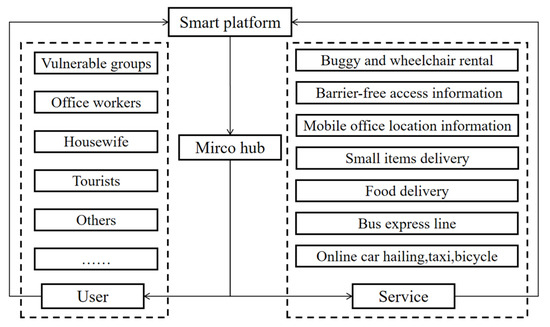
Figure 4.
Smart life micro-hub system created in the Shenzhen SDGs. Source: by author on the basis of data from [21,22].
3.1.4. Nanjing
The Nanjing Street Design Guidelines apply smart technologies to the areas of smart transportation, convenient living, and the protection of vulnerable people (Table 5) [23]. They also present the idea of an information platform that could share data on these application scenarios (Figure 5). The guidelines propose transportation solutions, such as a bus corridor, green-wave transportation, a parking guidance system, and transportation hubs to improve the efficiency of urban transportation. As relates to convenient living, urban furniture should be designed to achieve sustainable development functions, such as energy saving, a low carbon output, and self-sensing using loading sensors. Furthermore, the guidelines present methods to improve safety at street crossings for vulnerable people by implementing audio and infrared induction prompters.

Table 5.
The applications of smart technologies in the Nanjing SDGs. Source: by author on the basis of data from [23].

Figure 5.
The framework of the information platform presented in the Nanjing SDGs. Source: by author on the basis of data from [23].
3.1.5. Qingdao
The Qingdao Street Design Guidelines propose a method for extracting urban information using smart technologies to promote street management’s transformation toward a more sustainable orientation (Table 6) [24].

Table 6.
The applications of smart technologies in the Qingdao SDGs. Source: by author on the basis of data from [24].
The guidelines propose that traffic scheduling should be carried out based on the spatial–temporal characteristics of human and vehicle flows and should be supported by an intelligent cloud computing platform. As to convenient living, the guidelines point out that technologies such as oblique photography and portrait technology should be used to collect basic urban information (Figure 6). The guidelines also promote the design of smart electronic screens, and they advocate a combined functional structure for urban furniture to improve life services. In consideration of vulnerable people, high-density coverage sensors were proposed so as to optimize information dissemination channels.
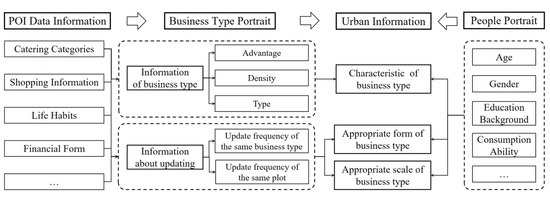
Figure 6.
Business activity measurement portrait system in Qingdao. Source: by author on the basis of data from [24].
3.2. Summary of Various Smart Technologies in SDGs
In summary, the applications of smart technologies to achieve sustainable development in each of the SDGs mainly concentrate on five aspects: travel and transportation information, the convenient integration of residents’ lives, improvement of the vitality of public facilities, protection of disadvantaged groups, and real-time monitoring of the living environment (Table 7). The raw data of selected cities on the application of smart technologies in the SDGs are shown in Tables S1–S5 in the Supplementary Material.

Table 7.
Summary of smart technologies for sustainable development in the SDGs. Source: By author.
- (1)
- Smart transportation technology focuses on the scheduling of multiple types of vehicles via traffic flow data and feedback to the platform. Based on the collection of traffic flow data, smart technologies can create an urban green-wave transportation and transport hub and build a static traffic guidance system.
- (2)
- In terms of convenient living, smart technology recommends the installation of multisource, interactive equipment in the urban furniture and advocates for more combined and functional furniture and facilities compatible with the necessities of everyday life, and it strives to handle daily business at the office building or home at any time.
- (3)
- The vital improvement of street space is created via art installations that employ listening, seeing, smelling, and tactile elements. Their wireless networks could collect interactive information from more comprehensive sources and use the portrait to propose targeted strategies.
- (4)
- For the protection of the vulnerable, smart technology can be implemented via thermal-sensing prompts and road studs at crossing facilities, and convenient urban furniture can be set up so vulnerable people can call for help, relying on real-time alarm-system monitoring and a one-button alarm device and by using tracking sensors to provide more comprehensive alarm information.
- (5)
- The collection of environmental monitoring information is mainly based on detection and interactive sensors. Smart vehicles have been designed on the principles of low carbon emissions and convenience. These collect and upload urban environmental data to the platform for analysis and use touchscreen media to achieve timely feedback.
3.3. Smart Street Management and Control Platform
The Smart Street Management and Control Platform (SSMCP) (Figure 7) consists of four layers: the basic information layer, technology platform layer, scene application layer, and institutional protection layer. The selected cases presented valuable techniques, development trends, and space demands, which could contribute to SSMCP development. For example, Figure 2, Figure 3 and Figure 4 are linked to the basic information layer and the scene application layer, which propose methods to acquire data, equip sensors, interact with people, and apply technologies. Figure 5 is linked to the technology platform layer, which presents the idea that a comprehensive information platform should be built to serve the whole city; the platform should be consistent, allowing some technologies to be supported and some functions to be realized. Figure 6 is linked to basic information layer, which shows some methods to record urban statistics as urban basic information.
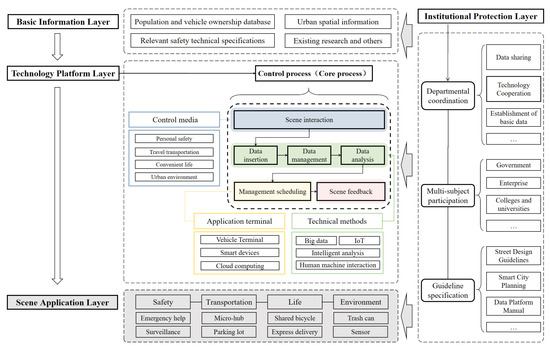
Figure 7.
The SSMCP for chinese cities. Source: by author.
3.3.1. Basic Information Layer
The basic information layer collects data maps from multiple departments. The project’s planning–construction–management process (whole-life cycle) must gradually promote linkages among departments, which can improve the efficiency of interdepartmental work in practice. A population database and vehicle ownership data are collected and updated based on the urban spatial information census data in this layer. Based on the relevant exceptional safety technical specifications and existing research, this layer enriches data lists and supports subsequent technical operations. The improvement of data collection provides strong support for city managers to make decisions. In practice, the collection of data can rely on various types of sensors equipped in the streets, and new methods can be applied to achieve it. As presented for previous SDGs, urban data can be captured from basic surveys, transportation statistics, and records on public services and the environment. Among these, radar, photography, and portrait technologies can contribute to measuring various types of basic information.
3.3.2. Technology Platform Layer
The technology platform layer is the core layer of the whole construction. Smart technologies in the street space are the carriers of information processing and exchange, as well as sharing and collaboration. The control media consider four scenarios: personal safety, travel transportation, life convenience, and the urban environment, which are scenarios for interactive responses and data collection in daily life. The data accessed from control media, together with the basic information from the upper layer, are sent to the scene interaction for a series of operations including data insertion, data management, and data analysis. These three operational processes are supported by big data, IoT, GPS, cloud computing, wearable technology, and other technical devices. According to the actual situation of each city, it is important to set different goals in management scheduling to achieve efficient operation on the streets. Based on the results produced by the above process, they are linked to the next layer in the scene feedback for presentation. In general, the information generated by residents’ participation in street activities is calculated in the corresponding media. With the basic information layer as a reference, the data are accessed, managed, and analyzed through the smart analytic platform. This layer can conduct analysis, automatically identify abnormalities, and realize the supervision of data. It is also the pre-processing stage of the scene application layer.
3.3.3. Institutional Protection Layer
The institutional protection layer guarantees the structure of the SSMCP from the perspectives of departmental coordination and multisubject participation. This layer is promoted by compiling corresponding documents, which also clarify the authority–responsiveness relationship and define the implementation and maintenance subjects for each layer of the platform. This layer establishes a multi-departmental and whole-process guarantee mechanism and improves the protection of specification documents, which in turn realize the operation and management of the whole SSMCP, and, finally, it achieves the goals of data collection, platform processing, rapid response, and collaborative feedback. Departmental coordination enables data sharing, technological cooperation, and the establishment of data framework, converged government, enterprise, and education institutions to achieve multi-subject participation, and enriches the types of guideline manuals used in academic research.
3.3.4. Scene Application Layer
Based on scenario feedback from the upper layer, the activities occurring in the street, the needs and possibilities of the current operation, and the final effects of the feedback are all expressed in the scene application layer. Consistent with the scenario types accessed from the control media, this layer presents the results through the same scenarios: safety, transportation, life, and environment. Security is represented by safety reminders and calling facilities in all kinds of urban furniture. The efficiency of mobility is optimized through the dispatching of vehicles and the prediction of traffic information. People can improve their quality of life based on the services they need. Feedback on the environment optimizes the efficiency of sanitation, greening, and other related departments and promotes sustainable development. This layer allows various smart technologies to be demonstrated, and residents are able to experience how the scenarios of safety, transportation, life, and environment are realized in the streets. Through the residents’ interactive experience, all kinds of facilities are connected to smart technologies and daily needs. Therefore, this layer can provide the most realistic picture of the SSMCP after being implemented in the street space. This layer could also visually demonstrate how the residents access a variety of smart technologies and how they fulfill their needs more sustainably.
4. Conclusions
Previous studies about smart cities have tended to be theoretical research, with less exploration of real cases. This paper studied the smart technologies of the street space. By sorting out the applications of smart technologies in several SDGs for five cities in China, the applications were categorized into five areas: smart transportation, convenient living, life enrichment, the protection of vulnerable people, and environmental monitoring. Then, to optimize the application of smart technologies, the SSMCP was explored. The SSMCP compounds the three functions of monitoring, controlling, and serving streets to create smart, efficient, vibrant, and safe streets. A response mechanism was constructed to enable data interaction, platform processing, and terminal feedback via four media, which included safety, transportation, life, and environment. Under the institutional protection of the system, the platform can improve the efficiency of data sharing and business collaboration among departments and enhance the sustainability and intelligence of the processes of “urban planning–construction–management” and holistic service. Smart technologies were used in the SSMCP to achieve street control, environmental management, and greater livability.
This conceptional and comprehensive framework for street space provides smart cities projects an actionable case and lays a foundation for future smart city advancement, which can be seen as a sample of smart city construction in practice, and can provide an original idea for a real street management platform in the future. The SSMCP could contribute to stock-based renewal and sustainable development, and the study could provide a reference for the implementation of smart cities in street space.
Because the selected cities were limited, it was not possible to summarize all the SDGs in China and all types of smart technologies according to region, and there was no section to illustrate how the SSMCP works in a certain city. Thus, in future studies, it is necessary to take more areas into account, to expand the scope of study, and to consider a practical example to explain the details.
Supplementary Materials
The following supporting information can be downloaded at: https://www.mdpi.com/article/10.3390/su15043438/s1, Table S1: The applications of smart technologies in the Beijing SDGs; Table S2: The applications of smart technologies in the Shanghai SDGs; Table S3: The applications of smart technologies in the Shenzhen SDGs; Table S4: The applications of smart technologies in the Nanjing SDGs; Table S5: The applications of smart technologies in the Qingdao SDGs.
Author Contributions
Conceptualization and methodology, F.X. and H.C.; data curation and investigation, F.X.; writing—original draft preparation, F.X.; writing—review and editing, H.C. and Y.W.; supervision and funding acquisition, H.C. All authors have read and agreed to the published version of the manuscript.
Funding
This research was funded by the National Natural Science Foundation of China, grant number 52170174.
Institutional Review Board Statement
Not applicable.
Informed Consent Statement
Not applicable.
Data Availability Statement
Not applicable.
Conflicts of Interest
The authors declare no conflict of interest.
References
- Gharaibeh, A.; Salahuddin, M.A.; Hussini, S.J.; Khreishah, A.; Khalil, I.; Guizani, M.; Al-Fuqaha, A. Smart Cities: A Survey on Data Management, Security, and Enabling Technologies. IEEE Commun. Surv. Tutor. 2017, 19, 2456–2501. [Google Scholar] [CrossRef]
- Zheng, Y.; Capra, L.; Wolfson, O.; Yang, H. Urban Computing: Concepts, Methodologies, and Applications. Acm Trans. Intell. Syst. Technol. 2014, 5, 1–55. [Google Scholar] [CrossRef]
- Qiu, B. Wisely and Actively Promote the Sustainable Development of Cities and Towns in China. Urban Dev. Stud. 2012, 19, 125–128. [Google Scholar] [CrossRef]
- Chinese Society for Urban Studies (Ed.) China Urban Planning and Development Report 2015–2016; China Architecture & Building Press: Beijing, China, 2016; pp. 10–25. ISBN 9787112195251. [Google Scholar]
- Kandt, J.; Batty, M. Smart cities, big data and urban policy: Towards urban analytics for the long run. Cities 2021, 109, 102–992. [Google Scholar] [CrossRef]
- Ismagilova, E.; Hughes, L.; Dwivedi, Y.K.; Raman, K.R. Smart cities: Advances in research—An information systems perspective. Int. J. Inf. Manag. 2019, 47, 88–100. [Google Scholar] [CrossRef]
- Silva, B.N.; Khan, M.; Han, K. Towards sustainable smart cities: A review of trends, architectures, components, and open challenges in smart cities. Sustain. Cities Soc. 2018, 38, 697–713. [Google Scholar] [CrossRef]
- Yigitcanlar, T.; Kamruzzaman, M.; Buys, L.; Ioppolo, G.; Sabatini-Marques, J.; da Costa, E.M.; Yun, J.J. Understanding ‘smart cities’: Intertwining development drivers with desired outcomes in a multidimensional framework. Cities 2018, 81, 145–160. [Google Scholar] [CrossRef]
- Allam, Z.; Dhunny, Z.A. On big data, artificial intelligence and smart cities. Cities 2019, 89, 80–91. [Google Scholar] [CrossRef]
- Lianfeng, W.; Gang, S.; Zhang, N.; An, X.; Liu, Z.; Jiang, X.; Zhu, H.; Wang, Z.; Mao, M.; Zhao, j.; et al. Construction of data model for smart city governance. Urban Dev. Stud. 2021, 28, 70–76+84. [Google Scholar] [CrossRef]
- Zhen, F.; Kong, Y. An Integrated “Human-technology-space” Framework of Smart City Planning. Urban Plan. Forum 2021, 6, 45–52. [Google Scholar] [CrossRef]
- Yang, J. A paradigm of urban big data application in planning and design: From data dimensioning to CIM platform. Beijing Plan. Rev. 2017, 15–20. [Google Scholar]
- Long, Y.; Zhang, E. Smart urban planning under the framework of data augmented design. City Plan. Rev. 2019, 43, 34–40. [Google Scholar] [CrossRef]
- Dang, A.; Zhen, M.; Wang, D.; Liang, J. Current situation and trends of the new smart city development in China. Sci. Technol. Rev. 2018, 36, 16–29. [Google Scholar] [CrossRef]
- de Jong, M.; Joss, S.; Schraven, D.; Zhan, C.; Weijnen, M. Sustainable–smart–resilient–low carbon–eco–knowledge cities; making sense of a multitude of concepts promoting sustainable urbanization. J. Clean. Prod. 2015, 109, 25–38. [Google Scholar] [CrossRef]
- Boeing, G. OSMnx: New methods for acquiring, constructing, analyzing, and visualizing complex street networks. Comput. Environ. Urban Syst. 2017, 65, 126–139. [Google Scholar] [CrossRef]
- Tao, F.; Qi, Q.; Wang, L.; Nee, A.Y.C. Digital Twins and Cyber–Physical Systems toward Smart Manufacturing and Industry 4.0: Correlation and Comparison. Engineering 2019, 5, 653–661. [Google Scholar] [CrossRef]
- Marzouk, M.; Othman, A. Planning utility infrastructure requirements for smart cities using the integration between BIM and GIS. Sustain. Cities Soc. 2020, 57, 102120. [Google Scholar] [CrossRef]
- Beijing Municipal People’s Government Home Page. Guidelines for Urban Design of Beijing Street Renewal and Governance. Available online: http://ghzrzyw.beijing.gov.cn/biaozhunguanli/bz/cxgh/202106/t20210623_2419742.html (accessed on 23 June 2021).
- Shanghai Municipal People’s Government Home Page. Shanghai Street Design Guidelines. Available online: https://hd.ghzyj.sh.gov.cn/zcfg/zhl/201610/t20161019_696909.html (accessed on 18 October 2016).
- Shenzhen Luohu District People’s Government Home Page. Guidelines for the Design of Complete Streets in Luohu District. Available online: http://www.szlh.gov.cn/zwgk/zcjd/2018/lhqwzjdsjdzgy/ (accessed on 30 September 2018).
- Shenzhen Futian District People’s Government Home Page. Futian District Street Design Guidelines. Available online: http://www.szft.gov.cn/attachment/1/1190/1190747/4350978.docx (accessed on 26 August 2020).
- Nanjing Municipal People’s Government Home Page. Nanjing Street Design Guidelines. Available online: http://ghj.nanjing.gov.cn/ghbz/cssj/201802/t20180208_875978.html (accessed on 8 February 2018).
- Qingdao Municipal People’s Government Home Page. Qingdao Street Design Guidelines. Available online: https://www.doc88.com/p-66716030504837.html (accessed on 30 November 2021).
- Lim, W.M.; Kumar, S.; Ali, F. Advancing knowledge through literature reviews: ‘what’, ‘why’, and ‘how to contribute’. Serv. Ind. J. 2022, 42, 481–513. [Google Scholar] [CrossRef]
- Marx, A.; Rihoux, B.; Ragin, C. The origins, development, and application of Qualitative Comparative Analysis: The first 25 years. Eur. Political Sci. Rev. 2014, 6, 115–142. [Google Scholar] [CrossRef]
- Jiang, Y.; Wang, Y.; Xie, J. Return to Human-oriented Streets: The New Trend of Street Design Manual Development in the World Cities and Implications for Chinese cities. Urban Plan. Forum 2012, 27, 65–72. [Google Scholar]
- Li, J.; Tang, Y.; Qi, M.; Peng, J. Street Design Guidelines Compilation For Urban Governance, Chaoyang District, Beijing. Planners 2018, 34, 42–48. [Google Scholar] [CrossRef]
- Zhang, F.; Luo, C.; Ge, Y. Thoughts innovations of Street Design Guidelines and planning transformation. Urban Plan. Forum 2018, 2, 75–80. [Google Scholar] [CrossRef]
- Zou, B. Practices, Effects, and Challenges of the Inventory Development Pattern: The Assessments and Extended Thoughts of Urban Renewal Implementation in Shenzhen. City Plan. Rev. 2017, 41, 89–94. [Google Scholar] [CrossRef]
- Song, Y.; Dong, Q.; Zhang, Y. A Study on the Representation of Hierarchical Structure of Block Form in Nanjing. Archit. J. 2018, 8, 34–39. [Google Scholar] [CrossRef]
Disclaimer/Publisher’s Note: The statements, opinions and data contained in all publications are solely those of the individual author(s) and contributor(s) and not of MDPI and/or the editor(s). MDPI and/or the editor(s) disclaim responsibility for any injury to people or property resulting from any ideas, methods, instructions or products referred to in the content. |
© 2023 by the authors. Licensee MDPI, Basel, Switzerland. This article is an open access article distributed under the terms and conditions of the Creative Commons Attribution (CC BY) license (https://creativecommons.org/licenses/by/4.0/).